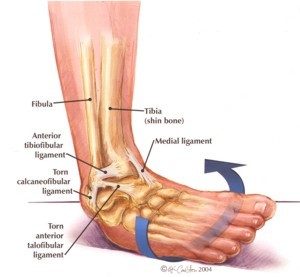We’ve all done it—rolled over on our ankles while running, playing a sport or just stepping off a curb the wrong way.
It hurts, it swells. It’s embarrassing. Perhaps you tried to “walk it off.”
Or perhaps you did all the right things to make it better, remembering the acronym RICE. That’s rest, ice, compression and elevation. Perhaps, you even spelled PRICE by adding protection.
But weeks, months, maybe years later, your ankle still just doesn’t feel right. Your balance is off on that leg. Or perhaps it’s painful to fully turn the ankle inward or it hurts when you squat. So you assume, or perhaps are told, that you have a “weak ankle,” because the ligament just didn’t heal properly. And there’s nothing you can do.
Think again!
New research has shown that ongoing ankle problems from a sprain are not the result of poor ligament healing, but rather involve issues with the ankle joint itself. The ligament, depending on the severity of the strain, heals fairly quickly, anywhere from a couple of weeks to just over two months.
Rather, the ongoing ankle pain may be due to a positional fault.
The ankle joint is comprised of the talus, an irregularly shaped bone with a dome, that sits between the specialized ends of the lower leg bones, the tibia and fibula. Together these two leg bones make the socket that holds the talus in place.
However, when we collapse on our ankle, not only can we sprain the ligament that holds the bones securely in place, but quite often the lower end of the fibula is pushed forward. The three bones no longer sit together properly in the joint, causing a positional fault.
If the talus bone is not seated correctly, it throws off the normal feedback loops and control mechanisms of the ankle, adversely affecting both balance and mobility.
This is not as severe as a dislocation, when the bone comes completely out of joint, nor a subluxation, when the bone comes partially out. However, it can cause long-term problems if left untreated.
New Zealand Physical Therapist Brian Mulligan has developed Mobilization With Movement manual therapy techniques that re-position the fibula in an easy and pain-free manner.
Once the talus is back in the groove, your ankle will function normally again, even after months or years of pain, discomfort or disability.
If you or someone you know has been complaining about a sore ankle, consider giving Mobilization With Movement therapy a try.
Bolton Hill neighbor Susan Lawrence is a physical therapist at Meadow Mill, susanlawrence.pt@gmail.com.

